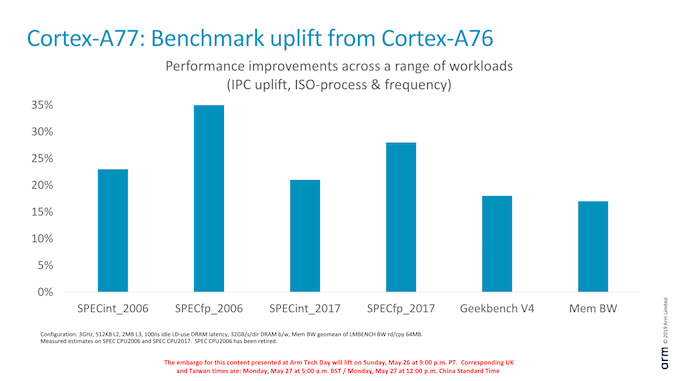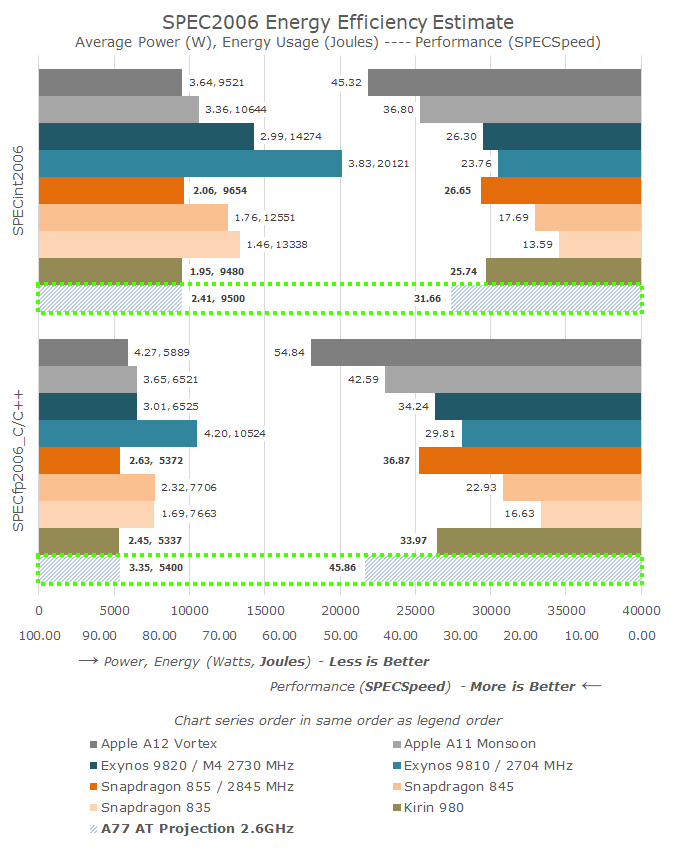Arm's New Cortex-A77 CPU Micro-architecture: Evolving Performance
by Andrei Frumusanu on May 27, 2019 12:01 AM ESTPerformance Targets: 20-35% Better IPC
The Cortex-A77 saw some interesting microarchitectural changes that promise to increase performance. The question now remains where exactly the targeted performance gains will end up at?
In terms of published performance improvements, Arm opted to stay with SPEC2006, 2017, GeekBench4 and LMBench memory bandwidth. Our focus here will be on SPEC2006 as it’s still the most relevant benchmark among the set for mobile.
On SPECint2006, the A77 promises around a 23% IPC increase, while SPECfp2006 claims a more staggering 35% boost. The 23% increase for integer workloads was more or less in line with what we expected of the CPU core, however the 30-35% increase for FP workloads I must admit came as quite a surprise, particularly since we haven’t seen any significant changes on the FP execution units of the core. An explanation here would be that SPEC’s FP test suite is more memory intensive than the integer suite, and the Cortex-A77’s various microarchitectural improvements would be more visible in these workloads.
Last year I had made performance and efficiency projections for the A76 at two frequency points, and I ended up being quite close to where the Kirin 980 and Snapdragon 855 ended up landing. For the Cortex-A77, things should be a lot more straightforward to project as we won’t see major process node changes in the next generation 7nm SoCs.
Baselining on the current results of the Kirin 980, I simply extrapolated performance based on the published IPC increases for a theoretical 2.6GHz Cortex-A77 SoC. It’s to be noted that although Arm this year again talks about 3GHz target frequencies for the A77, I’m not expecting vendors to quite reach this frequency in upcoming SoCs, thus the 2.6GHz projection.
In terms of performance, the integer suite would see some solid improvement, however the floating-point results are a lot more interesting. If correct, the A77 would exceed the FP performance of Apple’s A11 and make for quite a big generational push even though we’re not expecting big process node improvements. It’s to be noted though that the A77 will have to compete with Apple’s A13 later this year as well as next-gen M5 cores from Samsung.
Arm promises energy efficiency of the A77 will remain the same as current-gen A76 SoCs. Thus at peak performance, both CPU cores would use the same amount of energy to complete a set workload. The increased performance of the A77 would however have one drawback: Increased power usage, linear with the increased performance figures. This latter increased power usage would seemingly reach levels where running more than two cores at peak frequency would be more problematic in a mobile SoC. Luckily, most vendors have moved on from 4 full-speed big cores to 2+2 or 3+1 designs where there’s only one or two high-power big cores.
It’s to be noted although we’re talking about big cores here, the A77 is said to be only 17% bigger than the A76 – still significantly smaller than the next best microarchitecture from the competition.
End Remarks
Overall the Cortex-A77 announcement today isn’t quite as big of a change as what we saw last year with the A76, nor is it as big a change as today’s new announcement of Arm’s new Valhall GPU architecture and G77 GPU IP.
However what Arm managed to achieve with the A77 is a continued execution of their roadmap, which is extremely important in the competitive landscape. The A76 delivered on all of Arm’s promises and ended up being an extremely performant core, all while remaining astonishingly efficient as well as having a clear density lead over the competition. In this regard, Arm’s major clients are still heavily focusing on having the best PPA in their products, and Arm delivers in this regard.
The one big surprise about the A77 is that its floating point performance boost of 30-35% is quite a lot higher than I had expected of the core, and in the mobile space, web-browsing is the killer-app that happens to be floating point heavy, so I’m looking forward how future SoCs with the A77 will be able to perform.
But even in the integer workloads a 20-25% IPC gain is absolutely marvellous improvement, and we do trust Arm to be able to maintain energy efficiency of the A76. Power will go up slightly, but I think the industry has shown that mobile devices today handle at least two higher power cores properly, so future SoCs should continue with big+middle+little CPU configurations.
Coming A77 SoCs from vendors are expected to still be 7nm – Qualcomm and HiSilicon are the two obvious leading customers that would adopt the core and I’m expecting similar timeframes as last generation’s chipsets. For now- Arm’s delivering on their promised 20-25% yearly CAGR and we believe this to continue for the foreseeable next few generations.












108 Comments
View All Comments
abufrejoval - Monday, May 27, 2019 - link
While extending all that prefetching seems such a great thing for performance, it also expands the attack surface of side-channel attacks. So I wonder if the public awareness came to late in the game for this design for the team to review or even correct for that.SaberKOG91 - Monday, May 27, 2019 - link
And I suppose we should stop using branch prediction too because anything speculative is inherently insecure? /sWe've known about prefetch side-channel attacks for quite awhile now, as well as developed techniques to mitigate many of them. Do you really think ARM are so unaware of these issues?
rahvin - Tuesday, May 28, 2019 - link
Although side-channel attacks have been known about for a long time, the first viable attack wasn't developed until last year and there has been a steady stream of additional viable attacks since the first. In fact it's arguable that the severity of the attacks is going up with each discovery.They called it Spectre for a reason, they figured it was going to haunt computer design for the foreseeable future. Side channel attacks are here to stay and they aren't done finding new ones. Though we can't abandon speculative execution, any company that didn't take into account this attack method in future designs was foolish.
SaberKOG91 - Wednesday, May 29, 2019 - link
I don't disagree with any of your statements. I was annoyed by their ignorant attitude towards the importance of speculative features of modern CPU design. We need them for the sake of performance and there shouldn't need to be a steep trade-off between security and performance in order to keep these features. It's clear that AMD were able to design a more secure core that isn't affected by many of the side-channel attacks that Intel are vulnerable to, without a huge performance tradeoff. I doubt that ARM would willingly repeat these mistakes now that these attacks are known.rocky12345 - Wednesday, July 3, 2019 - link
Just a question I guess wasn't Spectre just what they called it when they found that someone could exploit the CPU like that. Up until then and I do not think there has been any real attacks that came out of this yet. My point is what if they did not make Spectre public and just fixed it behind closed doors. Then neither us or the attackers would have been clued in to it all. Also then there would not have been all these other finds for maybe attacks as well since then. I guess what I am saying sometimes us the public do not need to know some of these things because it just might also inform the low life's that like to do these exploits. Just my 2 cents worth and opinion on it all.syxbit - Monday, May 27, 2019 - link
I know you brought up Apple multiple times, but I really wish it got brought up even more. Every Q&A with ARM should say "Hey, stop boasting until you catch up to Apple"It's frustrating as an Android user to have seriously inferior SoCs....
Nozuka - Monday, May 27, 2019 - link
Even more frustrating to have one of these SoCs, but nothing actually uses its power...Unless you count bragging rights
Wilco1 - Monday, May 27, 2019 - link
Define inferior. Phone SoCs are not just about maximum single threaded performance. And Apple users found out the performance cannot be sustained by batteries...Android users get better power efficiency and lower cost phones due to lower die size of SoCs. As Andrei has shown, simply chasing high benchmark scores (like Samsung did with their custom cores) does not seem to work out so well.
syxbit - Monday, May 27, 2019 - link
Lower cost phones?Flagships from Google and Samsung cost the same as an iPhone, and the iPhone trounces them in performance.
Wilco1 - Monday, May 27, 2019 - link
There are plenty high-end Android phones which cost about half of an equivalent iPhone. Eg. OnePlus 7 Pro is $699 with 256GB flash vs $1249 for a similar spec Xs Max.